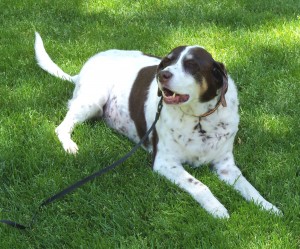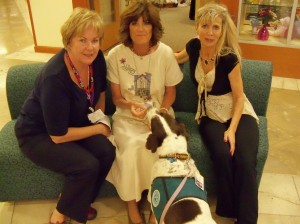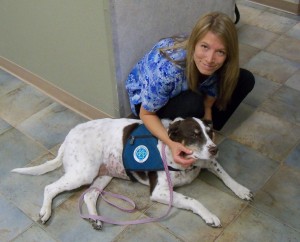Tilda is Assigned a Treatment Within CSU Clinical Trials.
On Monday, June 27th, Tilda was randomly assigned to the “Palladia Treatment System” within the CSU Clinical Trials for Canine Mast Cell Tumor Cancer. The Palladia treatment is not Chemotherapy, but rather a strong drug given by pill every other day.
Tilda has also been assigned a new Doctor at CSU for the Clinical Trials. Her name is Dr. Kristen Weishaar and she works with Dr. Doug Thamm who is the Principle Investigator for the CSU Clinical Trials program.
It was confirmed that Tilda does indeed have a Grade 3 Mast Cell Tumor invasion (very aggressive) and the stage of the cancer is Stage 3 (shows progressively greater signs of invasion with multiple tumors, etc.). The likelyhood of turning this invasion around is not a good scenario, but we already knew that and why Tilda is in the Clinical Trials. The good news is she can offer her assistance in testing a new drug that may or may not be a tremendous influence on this disease. She is fortunate to be testing this for safety, side effects and effectiveness against the disease.
What are Mast Cell Tumors?
Mast Cell Tumors are cancerous proliferations of mast cells. Although they can and will spread throughout the body, the danger from mast cell tumors arises from the secondary damage caused by the release of chemicals they produce. These chemicals can cause systemic problems that include gastric ulcers, internal bleeding, and a range of allergic manifestations. Clearly, mast cell tumors are referred to as “the great imposters” as there is no way to definitely identify them without a biopsy and pathology report. Mast cell tumors vary widely in their size, shape, appearance, texture, and location. It can be difficult not only to recognize mast cell tumors, but to predict their course. They may be relatively innocent or aggressively malignant. As mast cell tumors are very common in dogs, it is important for the regular pet owner to have at least a basic understanding of what they are and how they work.
Mast cells are specialized cells that normally are found distributed throughout the body and help an animal respond to inflammation and allergies. Mast cells can release several biologically active chemicals when stimulated, among them histamine, heparin, seratonin, prostaglandins and proteolytic enzymes. Although these chemicals are vital to normal bodily function, especially immune response, they can be very damaging to the body when released in chronic excess.
Following are the CSU instructions given to us for Tilda to follow:
Clinical Trials: Instructions for Palladia Administration
Palladia is a new drug approved for the treatment of mast cell tumors in dogs. Evidence suggests that it may also have activity against other tumor types, and studies are ongoing to evaluate this activity. Palladia works by blocking a variety of receptors (PDGFR, VEGFR, Flt3) on the surface of the tumor cells and blood vessel cells. These receptors signal into the cell and Palladia blocks their ability to signal. In the case of mast cell tumors, the tumor cells often rely upon Kit for survival. In the case of new blood vessels, they often rely upon PDFGR and VEGFR for survival. In this way, Palladia can act as both
an anti-tumor and anti-angiogenic (blood vessel) drug, working to possibly kill the tumor cells and prevent the growth of new blood vessels into the tumor. Palladia is not a true chemotherapy agent, but because it has the ability to block blood vessel growth, women who are pregnant or trying to get pregnant should not handle the drug.
While Palladia is often well tolerated by dogs, it can cause a number of clinical side effects. Most of these are very easy to treat if caught early. In general, all dogs that receive Palladia will likely have some side effects at some point that are usually transient in nature and readily treatable. In fact, many dogs will stay on Palladia for 6 months or longer with an excellent quality of life. However, it is very important that the dog is monitored closely for any of the signs listed below:
- Picky Eating
- Loose stool/diarrhea
- Blood in the stool
- Vomiting
- Lethargy
- Stiffness
Nearly all of these side effects can be treated with either a dose reduction, the addition of other medications, or both. I you cannot immediately reach a clinician at CSU and you are not sure whether you should give the next dose of Palladia because of side effects, just skip the dose until you are able to speak with someone.
We look forward to working with you during your dog’s Palladia treatment. Please feel free to contact us if you have any questions at all as we want your dog’s experience on Palladia to be a good one.
Signed,
Dr. Kristen Weisharr
So Far, So Good!
Tilda has been on the Palladia treatment program for one week now and there have been no side effects noticed from the Palladia. She is given the Palladia pills every other day with Prednisone on the alternate days. The Prednisone days seem to be the most difficult days for her and maybe that will have to be adjusted by CSU doctors. We go back for a checkup exam on Tuesday, July 5th. Her total number of bumps on her skin now number 104 in total count.
Tilda has had a marked improvement of her life quality over the past week. She is doing
very well and looking great. She has been so spunky and ready to go somewhere to visit that I asked the program leads at the hospitals if it would be okay to visit staff and some of Tilda’s favorite people. We received that approval so on Wednesday, June 29th, Tilda visited Longmont United Hospital for about 2 hours with lots of rest periods in between. Friday we did some visiting at Boulder Community Hospital, then went on the Avista Hospital and Exempla Hospital for a couple visits each. As long as she could rest a bit now and then, she did great. Tilda actually tried to have a “soul seaching” event with a staff member at one of the hospitals on Friday and made several attempts to reach this person for whatever reason. It was quite a dramatic event and it was great fun to feel her energy again. This visit was so pointed with Tilda’s extreme concentration that after we left that staff member and went down the hall about 40 feet, Tilda turned around and pulled me back into the office of that staff member again (which was not easy to find, but she went directly to it). There she took her stance once more trying to connect with a person she had never met before this day. All I can say is that it’s an amazing experience to witness this part of Tilda and I am so thankful that she is still able to give it a try. I will tell the whole story another time.




